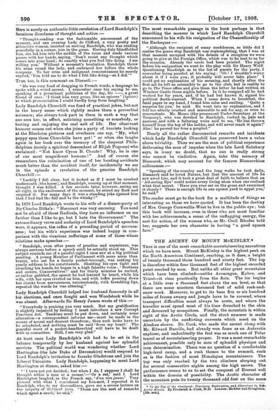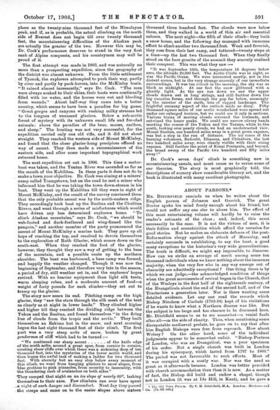THE ASCENT OF MOUNT McKINLEY.*
THIS is one of the most remarkable mountaineering narratives which we have seen. Mount McKinley is the highest peak on the North American Continent, reaching, as it does, a height of twenty thousand three hundred and ninety feet. The top is therefore within four thousand feet of the highest recorded point reached by man. But unlike all other great mountains which have been climbed—unlike Aconcagua, Kabru, and Trisul—it rises practically from the flats. The ice begins at a little over a thousand feet above the sea level, so that there are some nineteen thousand feet of solid rock-and- snow work. Moreover, to get to its base five or six hundred miles of frozen swamp and jungle have to be covered, where transport difficulties must always be acute, and where the traveller must spend most of his time drenched to the skin and devoured by mosquitoes. Finally, the mountain is within sight of the Arctic Circle, and the short summer is made uncertain by the conflicting currents which meet on the Alaskan shores. Dr. Cook, who made the ascent along with Mr. Edward Barrille, had already won fame as an Antarctic explorer, and undoubtedly the feat was as much one of Polar travel as of mountaineering proper. It was a most remarkable achievement, possible only to men of splendid physique and iron determination. There was no question of a comfortable high-level camp, and a rush thence to the summit, such as is the fashion of most Himalayan mountaineers. The top was only reached by the two climbers sleeping out for several consecutive nights among the high snows. The performance seems to us to set- the conquest of Everest well within the domain of possibility. The Arctic character of the mountain puts its twenty thousand odd feet on the same • To the Top of the Continent: lYscovery, Exploration, and Adrentnre in Sub. Arctic Alaska. By Fre1erick A. Cook, M.D. London: Hodder and Stoughton. [12e. net.]
plane as the twenty-nine thousand feet of the Himalayan peak, and if, as is probable, the actual climbing on the north side of Everest does not begin till over twenty thousand feet, the mountaineering difficulties of the Alaskan peak are actually the greater of the two. However this may be, Dr. Cook's performance deserves to stand in the very first rank of Alpine conquests, and his countrymen may well be proud of it.
The first attempt was made in 1903, and was naturally no more than a prospecting expedition, since the geography of the district was almost unknown. From the little settlement of Tyonok, the explorers attempted to push their way, partly by river and partly by pack-horses, into the McKinley basin.
"It rained almost incessantly," says Dr. Cook. "The men were always soaked to their skins, their boots were continually filled with ice water, and the horses were wet and bleeding from wounds." About half-way they came into a better country, which seems to have been a paradise for big game.
" Great gorges and canyons with rushing milky streams led to the tongues of unnamed glaciers. Below a sub-arctic forest of mystery with its unknown small life and fur-clad animals: above the paradise of the bear, moose, caribou, and sheep." The hunting was not very successful, for the expedition carried only one old rifle, and it did not shoot straight. They reached the western side of Mount McKinley, and found that the sheer glacier-hung precipices offered no way of ascent. They then made a reconnaissance of the eastern side, and after some important topographical work returned home.
The next expedition set out in 1906. This time a motor- boat was taken, and the Yentna River was ascended as far as the mouth of the Kabilitna. In these parts it does not do to make a town your objective. Dr. Cook was aiming at a miners' camp called Youngstown, but on the road be met a miner who informed him that he was taking the town down-stream in his boat. They went up the Kabilitna till they were in sight of Mount McKinley, and the result of time survey convinced them that the only probable ascent was by the north-eastern ridge. They accordingly took boat up the Susitna and the Chulitna Rivers, and went through a series of misfortunes which would have driven any less determined explorers home. "To climb Alaskan mountains," says Dr. Cook, "we should be web-footed and duck-feathered and wing-finned like the penguin," and another member of the party pronounced the ascent of Mount McKinley a marine task. They gave up all hope of reaching the top, and resolved to devote themselves to the exploration of Ruth Glacier, which comes down on the south-east. When they reached the foot of the glacier, however, they thought they saw a way of getting to the base of the mountain, and a possible route up the northern shoulder. The boat was harboured, a base camp was formed, and happily the weather changed. Though it was now the beginning of September, and therefore very late in the season, a period of dry, still weather set in, and the explorers' hopes revived. With no heavier equipment than light silk tents, warm sleeping robes, and a moderate amount of food—a weight of forty pounds for each climber—they set out to tramp up the glacier.
The story now nears its end. Pitching camp on the high glacier, they "saw the stars through the silk mesh of the tent as clearly as at night in lower lands." They climbed higher and higher till they reached the dividing ridge between the Yukon and the Susitna, and found themselves "in the firing line of clouds from the tropic and the arctic." They built themselves an Eskimo hut in the snow, and next morning began the last eight thousand feet of their climb. The first part was a very steep arde of snow, broken by great gendarmes of cliff which had to be turned :-
"We continued our sharp ascent of the knife edge -of the north arete, around a great spur, from cornice to cornice, -cresting sheer cliffs over which there was a sickening drop of ten -thousand feet, into the mysteries of the lower arctic world, and -then began the awful task of making a ladder for two thousand feet. With eternity but an easy step below every moment of this climb, we went from hanging glaciers to snow slopes, from blue grottoes to pink pinnacles, from security to insecurity, with -the thundering rush of avalanches on both sides."
'They camped that night on an ice slope of nearly 60°, lashing
themselves to their axes. Few climbers can ever have spent ..41 night of such danger and discomfort. Next day they passed
. the steeps and came on to the easier slopes above sixteen thousand three hundred feet. The clouds were now below them, and they walked in a world of thin air and essential colours. The next night—the fifth of their climb—they built a snow house, and the following day managed with immense effort to climb another two thousand feet. Weak and feverish, they rose from their last camp, and tottered—twenty steps at a time—up the last two thousand feet. When they finally stood on the bare granite of the summit they scarcely realised their conquest. This was what they saw
"It was September 16th, the temperature 16 degrees below zero, the altitude 20,390 feet. The Arctic Circle was in sight, so was the Pacific Ocean. We were interested mostly, not in the distant scenes, but in the very strange anomaly of our immediate surroundings. It was ten o'clock in the morning, the sky was as black as midnight. At our feet the snow glittered with a ghastly light. As the eye ran down we saw the upper clouds drawn out in long strings, and still further down the big cumulus forms, and through the gap far below, seemingly in the interior of the earth, bits of rugged landscape. The frightful uncanny aspect of the outlook made us dizzy. Fifty thousand square miles of our arctic wonderland were spread out under our enlarged horizon, but we could see it only in sections. Various trains of moving clouds screened the lowlands, and entwined the lesser peaks. We could see narrow silvery bands marking the course of the Yukon and the Tanana, while to the south, looking over pearly clouds, we had an unobstructed view. Mount Susitna, one hundred miles away in a great green expanse, was but a step in the run of distance. The icy cones of the burning volcanoes, Redoubt, Illiamua, and Chinabora, the last two hundred miles away, were clearly visible with their rising vapours. Still further the point of Kenai Peninsula, and beyond, the broad sweep of the Pacific two hundred and fifty miles away !"
Dr. Cook's seven days' climb is something new in mountaineering annals, and must cause us to revise some of our theories. The story is most graphically told, the descriptions of scenery show considerable literary art, and the book is illustrated with many excellent photographs.















































 Previous page
Previous page